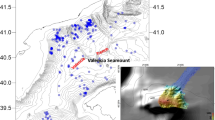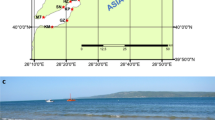Abstract
We studied the sclerobiont community associated with organogenic and lithic cobbles from soft bottoms in the Khao Lak coastal area (Andaman Sea) that was damaged by the 2004 tsunami. The 15 cobbles examined originate from grab and hand sampling carried out in the years 2006 and 2007 in the depth range of 4.6–15.2 m. A rich endo- and epibenthos was identified, mainly consisting of algae, foraminifers, sponges, cnidarians, polychaetes, bryozoans and bivalves. Associations on each examined cobble show similarities in composition and structure being characterized by a few dominant groups. Differences were noted in the degree and pattern of colonization, distinguishing for each cobble an upward and a downward side at the time of sampling. The mean total coverage is 15.09% being higher on the upper sides (17.4%) compared to the lower sides (12.8%). Calcareous algae, bivalves and sponges prevail on upper sides, while bryozoans prevail on lower sides. The sclerobionts distribution allowed to infer the orientation of cobbles on the seafloor during colonization. Major colonization values, exceeding 30% coverage, were observed on organogenic cobbles located in the proximity of reefs or collected from below 12 m of water depth. Conversely, cobbles from the shallowest stations result poorly colonized, independently of their composition. The water turbidity and wave motion as a possible cause of the observed distributions were discussed. The Khao Lak cobble community seems to be largely unaffected by the tsunami event, as suggested by the estimated biodiversity, abundance and coverage of sclerobionts.









Similar content being viewed by others
References
Barrio Frojan CRS, Hawkins LE, Aryuthaka C, Nimsantijaroen S, Kendall MA, Paterson GLJ (2005) Patterns of polychaete communities in tropical sedimentary habitats: a case study in south-western Thailand. The Raffles Bull Zool 53:1–11
Barrio Froján CRS, Kendall MA, Paterson GLJ, Hawkins LE, Nimsantijaroen S, Aryuthaka C (2006) Patterns of polychaete diversity in selected tropical intertidal habitats. In: Sardá R, San Martín G, López E, Martin D, George D (eds) Scientific advances in polychaete research. Sci Mar 70(suppl 3):239–248
Bishop JDD (1989) Colony form and the exploitation of spatial refuges by encrusting Bryozoa. Biol Rev 64:197–218
Boonlert P (1992) Preliminary report on the polychaetes from the fifth Thai-Danish expedition along the Andaman Sea coast of Thailand. Phuket Mar Biol Cent Res Bull 57:77–88
Caragnano A, Colombo F, Rodondi G, Basso D (2009) 3-D distribution of nongeniculate corallinales: a case study from a reef crest of South Sinai (Red Sea, Egypt). Coral Reefs 28:881–891
Choi DR (1984) Ecological succession of reef cavity-dwellers (coelobites) in coral rubble. Bull Mar Sci 35:72–79
Choi DR, Ginsburg RN (1983) Distribution of coelobites (cavity-dwellers) in coral rubble across the Florida reef tract. Coral Reefs 2:165–172
Choowong M, Murakoshi N, Hisada K, Charusiri P, Daorerk V, Charoentitirat T, Chutakositkanon V, Jankaew K, Kanjanapayont P (2007) Erosion and deposition by the 2004 Indian Ocean tsunami in Phuket and Phang-nga Provinces, Thailand. J Coast Res 23(5):1270–1276
Dexter DM (1996) Tropical sandy beach communities of Phuket island, Thailand. Phuket Mar Biol Cent Res Bull 61:1–28
Di Geronimo I, Robba E, Charusiri P, Chowoong M, Agostino I, Martino C, Di Geronimo R, Phantuwongraj S (2008) Marine modern sediments and rocky bottoms of Khao Lak coastal area, Changwat Phang Nga, Andaman Sea, SW Thailand. Color Map 1:30.000, Catania, Bangkok
Di Geronimo I, Choowong M, Phantuwongraj S (2009) Geomorphology and superficial bottom sediments of Khao Lak coastal area (SW Thailand). Polish J Environ Stud 18(1):111–121
Fabricius K, De’ath G (2001) Environmental factors associated with the spatial distribution of crustose coralline algae on the Great Barrier Reef. Coral Reefs 19:303–309
Gischler E (1997) Cavity dwellers (coelobites) beneath coral rubble in the Florida reef tract. Bull Mar Sci 61:476–484
Gischler E, Ginsburg RN (1996) Cavity dwellers (coelobites) under coral rubble in southern Belize barrier and atoll reefs. Bull Mar Sci 58:570–589
Gordon DP, Taylor PD, Bigey FP (2009) Phylum Bryozoa. Moss animals, sea mats, lace corals. In: Gordon DP (ed) New Zealand inventory of biodiversity, vol 1. Kingdom Animalia, pp 271–297
Hirata T (1987) Succession of sessile organisms on experimental plates immersed in Nabeta Bay, Izu Peninsula, Japan. II. Succession of invertebrates. Mar Ecol Prog Ser 38:25–35
Jackson JBC (1984) Ecology of cryptic coral reef communities. III. Abundance and aggregation of encrusting organisms with particular reference to cheilostome Bryozoa. J Exp Mar Biol Ecol 75:37–57
Jackson JBC, Winston JE (1982) Ecology of cryptic coral reef communities. I. Distribution and abundance of major groups of encrusting organisms. J Exp Mar Biol Ecol 57:135–147
Kendall MA, Paterson GLJ, Aryuthaka C, Nimsantijaroen S, Kongkaeow W, Whanpetch N (2006) Impact of the 2004 Tsunami on intertidal sediment and rocky shore assemblages in Ranong and Phang Nha Provinces, Thailand. Phuket Mar Biol Cent Res Bull 67:63–75
Kendall MA, Aryuthaka C, Chimonides J, Daungnamon D, Hills J, Jittanoon C, Komwachirapitak P, Kongkaew V, Mittermeyr A, Monthum Y, Nimsantijaroen S, Paterson GlJ, Foster-Smith R, Foster-Smith J, Thongsin N (2009) Post-tsunami recovery of shallow water biota and habitats on Thailand’s Andaman coast. Polish J Environ Stud 18(1):69–75
Kupriyanova EK, Nishi E, ten Hove HA, Rzhavsky AV (2001) Life-history patterns in serpulimorph polychaetes: ecological and evolutionary perspectives. Oceanogr Mar Biol Annu Rev 39:1–101
Lombardi C, Cocito S, Hiscock K, Occhipinti-Ambrogi A, Setti M, Taylor PD (2008) Influence of seawater temperature on growth bands, mineralogy and carbonate production in a bioconstructional bryozoan. Facies 54:333–342
Martindale W (1992) Calcified epibionts as palaeoecological tools: examples from the recent and Pleistocene reefs of Barbados. Coral Reefs 11:167–177
McGiunness KA (1987a) Disturbance and organisms on boulders. I. Patterns in the environment and the community. Oecologia 71:409–419
McGiunness KA (1987b) Disturbance and organisms on boulders. II. Causes of patterns in diversity and abundance. Oecologia 71:420–430
McKinney FK (1996) Encrusting organisms on co-occurring disarticulated valves of two marine bivalves: comparison of living assemblages and skeletal residues. Paleobiology 22(4):543–567
Meesters E, Knijn R, Willemsen P, Penanrtz R, Roebers G, van Soest WM (1991) Sub-rubble communities of Curaçao and Bonaire coral reefs. Coral Reefs 10:189–197
Natheewathana A, Hylleberg J (1991) Magelonid polychaetes from Thailand, the Andaman Sea, with descriptions of eight new species. Ophelia Suppl 5:169–184
Neal LA, Wilson MA, Curran HA (1988) Distribution and ecology of marine pebble and cobble communities on San Salvador Island, Bahamas. North-Central Section Meeting, Geological Society of America Abstracts with Programs 20(5): 382–383
Nebelsick JH, Schmid B, Stachowitsch M (1997) The encrustation of fossil and recent sea-urchin tests: ecological and taphonomic significance. Lethaia 30:271–284
Perry CT, Hepburn LJ (2008) Syn-depositional alteration of coral reef framework through bioerosion, encrustation and cementation: taphonomic signatures of reef accretion and reef depositional events. Earth Sci Rev 86:106–144
Rasser MW, Riegl B (2002) Holocene coral reef rubble and its binding agents. Coral Reefs 21:57–72
Richter C, Wunsch M, Rasheed M, Kötter I, Badran MI (2001) Endoscopic exploration of Red Sea coral reefs reveals dense populations of cavity-dwelling sponges. Nature 413:726–730
Tantanasiriwong R (1978) An illustrated checklist of marine shelled gastropods from Phuket Island, adjacent mainland and offshore islands, western peninsular Thailand. Phuket Mar Biol Res Bull 21:1–22
Tantanasiriwong R (1979) A checklist of marine bivalves from Phuket Island, adjacent mainland and offshore islands, western peninsular Thailand. Phuket Mar Biol Res Bull 27:1–15
Taylor PD, Wilson MA (2002) A new terminology for marine organisms inhabiting hard substrates. Palaios 17:522–525
Taylor PD, Wilson MA (2003) Palaeoecology and evolution of marine hard substrate communities. Earth Sci Rev 62:1–103
Titov V, Rabinovich AB, Mofjeld HO, Thomson RE, González FI (2005) The global reach of the 26 December 2004 Sumatra tsunami. Science 309:2045–2048
Vasuki S, Ganesan M, Subba Rao PV (2001) Effect of light intensity, photoperiod, ESP medium and nitrogen sources on growth of marine brown alga Padina boergesenii (Dictyotales, Phaeophyta). Indian J Mar Sci 30(4):228–231
Wilson MA (1987) Ecological dynamics on pebbles, cobbles, and boulders. Palaios 2:594–599
Winston JE, Jackson JBC (1984) Ecology of cryptic coral reef communities. IV. Community development and life histories of encrusting Cheilostome Bryozoa. J Exp Mar Biol Ecol 76:1–21
Yeemin T, Sutthacheep M, Pettongma R (2006) Coral reef restoration projects in Thailand. Ocean Coast Manag 49:562–575
Zuschin M, Baal C (2007) Large gryphaeid oysters as habitats for numerous sclerobionts: a case study from the northern Red Sea. Facies 53(3):319–327
Zuschin M, Hoenegger J, Steininger FF (2001) Molluscan assemblages on coral reefs and associated hard substrata in the northern Red Sea. Coral Reefs 20:107–116
Acknowledgments
This research was funded by MURST grants (PRIN 2005: Programmi di ricerca di Rilevante Interesse Nazionale, 2005048829 Project). Catania Palaeontological Research Group: contribution number 363.
Author information
Authors and Affiliations
Corresponding author
Rights and permissions
About this article
Cite this article
Sanfilippo, R., Rosso, A., Basso, D. et al. Cobbles colonization pattern from a tsunami-affected coastal area (SW Thailand, Andaman Sea). Facies 57, 1–13 (2011). https://doi.org/10.1007/s10347-010-0226-0
Received:
Accepted:
Published:
Issue Date:
DOI: https://doi.org/10.1007/s10347-010-0226-0




